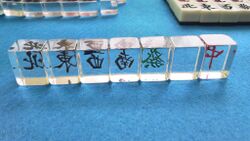Washizu mahjong

Washizu Mahjong is a style of mahjong play, where three tiles for every tile type are transparent. As a consequence, players are able to see most of the other players' hands. That aspect alone alters player approaches to the game in both terms of play style and strategy. The variant originated from the key arc of the 1991 manga series Akagi.
Tiles
Of the tiles, three out of four of each type are transparent. This is made possible in the material. Clear plastic, acrylic, or even glass may be used for transparency. Other methods of implementation may involve different colored tiles. Tiles indicated as "transparent" are played face-up.
Main game rule differences
The main rules to the game is retained. Rules dictating yaku, furiten, completed hands, and any selected rule variations still apply. Nevertheless, the game is significantly altered.
The game processes are altered, because three of each tile type are transparent. The tiles are not set up in walls. Likewise, a physical dead wall is not used either. Instead, all the tiles are mixed into a non-transparent bag for players to draw from. To draw tiles, players wear gloves to draw tiles and not read them with the hand. Furthermore, players are not required to arranged tiles in the hand in a specific order. This allows players to mask the use of opaque tiles to hint some tile disinformation. Finally, to mark a dora, one tile is automatically drawn at the beginning of the game. Additional dora as either kandora or any uradora, they are drawn in a similar fashion.
In computer game interfaces, the wall is not necessarily displayed on screen. In the case of Majsoul, the game does not display the wall at all under any game mode. This makes implementation of Washizu mahjong possible. Thus, the game can be played "normally".
Strategy
Game strategy is altered from the additional information of tiles in player hands. This increases a player's ability to count tiles and assess tile availability. Likewise player defense uses that information as well. Possible player waits are either known or inferred.
External links
- Washizu (YouTube)
- A demonstration how Washizu Mahjong will be played during the 'Washizu in Holland Tournament', Nijmegen, the Netherlands, April 17th, 2010.